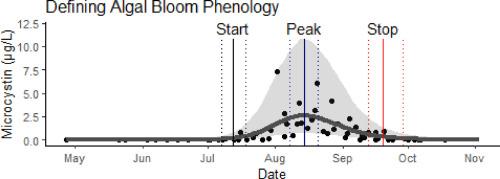伊利湖藻华物候的定义
IF 5.5
1区 生物学
Q1 MARINE & FRESHWATER BIOLOGY
引用次数: 0
摘要
阐明全球气候变化对水生生态系统的影响,特别是通过初级生产者的物候变化产生的影响,对于了解生态恢复能力至关重要。在这里,我们重点研究了作为水生生态系统(特别是伊利湖)中藻类生物量和初级生产量替代物的叶绿素的物候变化以及毒素微囊藻毒素的浓度。通过跟踪叶绿素和微囊藻毒素的时间变化,我们确定了对估计有害藻华(HABs)的持续时间、规模和强度非常重要的关键物候期。确定哪些生物和非生物影响因素(如温度、风速、营养供应和气候变化)最为重要,是伊利湖的一项长期管理需求,可以利用我们的方法进行探索。我们采用贝叶斯广义加性混合模型的新型统计框架描述了伊利湖的季节性叶绿素和微粒微囊藻毒素浓度,我们的简单几何方法确定了藻华的开始、高峰和结束时间。这项研究加深了我们对营养物污染对水生生态系统生态影响的理解,并提供了一种可重复的方法来确定物候事件,而无需用户定义临界值,这有助于管理和缓解有害藻类繁殖,保护依赖湖泊提供饮用水的地区的水质。本文章由计算机程序翻译,如有差异,请以英文原文为准。

Defining algal bloom phenology in Lake Erie
Elucidating the impact of global climate change on aquatic ecosystems, particularly through phenological shifts in primary producers, is critical for understanding ecological resilience. Here, we focus on the phenological shifts in chlorophyll as a proxy for algae biomass and primary production in aquatic ecosystems, specifically in Lake Erie as well as concentrations of the toxin microcystin. By tracking temporal changes in each, we identified key phenological phases important to estimate duration, magnitude, and intensity of harmful algal blooms (HABs). Determining which influential biotic and abiotic factors such as temperature, wind speed, nutrient availability, and climate change is most important, is a long-term management need for Lake Erie, which can be explored using our methodology. Our novel statistical framework employing Bayesian generalized additive mixed models described seasonal chlorophyll and particulate microcystin concentration from Lake Erie and our simple geometric method identified the start, peak, and end of algal blooms. This research enhances our understanding of the ecological effects of nutrient pollution on aquatic ecosystems and provides a repeatable method for determining phenological events without the need for user defined cutoffs which aids in the management and mitigation of HABs, safeguarding water quality in regions dependent on lakes for drinking water.
求助全文
通过发布文献求助,成功后即可免费获取论文全文。
去求助
来源期刊

Harmful Algae
生物-海洋与淡水生物学
CiteScore
12.50
自引率
15.20%
发文量
122
审稿时长
7.5 months
期刊介绍:
This journal provides a forum to promote knowledge of harmful microalgae and macroalgae, including cyanobacteria, as well as monitoring, management and control of these organisms.
 求助内容:
求助内容: 应助结果提醒方式:
应助结果提醒方式:


